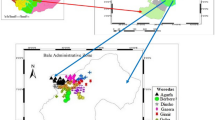Summary
Populations of wild barley, Hordeum spontaneum, in Israel, originating from diverse habitats, and tested earlier for allozyme (Nevo et al., 1979a) and disease resistance polymorphisms (Moseman et al., 1984; Nevo et al., 1984a), were compared and contrasted for performance in agronomically important phenotypic traits. The traits compared involved 10 variables comparing germination, earliness, numerical and weight variables of biomass and yield. The field experiments were conducted in 1980, 1981 and 1982 in two relatively standardized and contrasting environments: mesic (Mount Carmel, Haifa) and xeric Avedat farm, and Sede Boqer (both in the northen Negev desert). The experimental design involved 26 population quadrangles at Avedat farm (1980), and rows of randomized plants of 11 populations in both Haifa and Sede Boqer (1981 and 1982).
The results indicate that the characters studied are partly genetically determined. Striking genetic variation was found between and within populations in each site, whereas remarkable environmental variation including genetic environmental interaction was found between the mesic and the xeric sites, as well as between populations and years. We conclude that natural populations of wild barley in Israel vary not only in genetic polymorphisms of allozymes and disease resistance, but also in quantitative traits of agronomie importance. These traits are economically significant and should be conserved and utilized in barley crop improvement.
Similar content being viewed by others
References
Atlas of Israel, 1970. Survey of Israel. Jerusalem: Ministry of Labour. Amsterdan: Elsevier Pub. Co.
Brown A. H. D. & J. Munday, 1982. Population genetic structure of land races of barley from Iran. Genetica 58: 85–96.
Evenari M., L. Shanan & N. Tadmor, 1971. The Negev. The challenge of a desert. Cambridge: Harvard university Press.
Feldman M. & E. R. Sears, 1981. The wild gene resources of wheat. Scie. Amer. 244: 101–112.
Frankel O. H. & E. Bennett, 1970. Genetic resources in plants—their exploration and conservation. Oxford. Blackwell Publ.
Frankel O. K. & M. Soulé, 1981. Conservation and evolution. Cambridge: Cambridge University Press.
Harlan J. R., 1976. Genetic resources of wild relatives of crops. Crop Sci. 16: 329–333.
Harlan J. R., J. M. J.De Wet & E. G. Price, 1973. Comparative evolution of cereals. Evolution 27: 311–325.
Moseman, J. G., E. Nevo & D. Zohary, 1984. Resistance of Hordeum spontaneum collected in Israel to infection with Erysiphe graminis hordei. Euphytica (in press).
Nevo E., D. Zohary, A. H. D. Brown & M. Haber, 1979a. Genetic diversity and environmental associations of wild barley, Hordeum spontaneum in Israel. Evolution 33: 815–833.
Nevo E., A. H. D. Brown & D. Zohary, 1979b. Genetic diversity in the wild progenitor of barley in Israel. Experientia 35: 1027–1029.
Nevo E., E. M. Golenberg, A. Beiles, A. H. D. Brown & D. Zohary, 1982. Genetic diversity and environmental associations of wild wheat Triticum dicoccoides, in Israel. Theor. Appl. Genet. 62: 241–254.
Nevo E., J. G. Moseman, A. Beiles & D. Zohary, 1984a. Correlation of ecological factors and allozymic variations with resistance to Erysiphe graminis hordei in Hordeum spontaneum in Israel: patterns and application. Plant Syst. and Evol. 145: 79–96.
Nevo, E., J. G. Moseman, A. Beiles & D. Zohary, 1984b. Patterns of resistance of wild wheat to pathogens in Israel: I. Predictive method by ecology and allozyme genotypes. (submitted).
Nevo, E., A. Beiles, Y. Gutterman, N. Storch & D. Kaplan, 1984c. Genetic resources of wild cereals in Israel and vicinity. I. Phenotypic variation within and between populations of wild wheat, Triticum dicoccoides. Euphytica (in press).
Plucknett D. L., N. J. H. Smith, J. T. Williams & N. M. Anishetty, 1983. Crop germplasm conservation and developing countries. Science 220: 163–169.
SPSSx, 1983. User's guide. New York: McGrawhill Co.
Thornthwaite C. W., 1948. An approach toward a rational classification of climate. Geogr. Rev. 38: 55–94.
Zohary D., 1969. The progenitors of wheat and barley in relation to domestication and agricultural dispersal in the old world. In: P. J. Ucko & G. W. Dimbleby (Eds), The domestication and exploitation of plants and animals. Gerald Duckworth and Co. Ltd, London.
Author information
Authors and Affiliations
Rights and permissions
About this article
Cite this article
Nevo, E., Beiles, A., Gutterman, Y. et al. Genetic resources of wild cereals in Israel and vicinity. II. Phenotypic variation within and between populations of wild barley, Hordeum spontaneum . Euphytica 33, 737–756 (1984). https://doi.org/10.1007/BF00021901
Received:
Issue Date:
DOI: https://doi.org/10.1007/BF00021901




